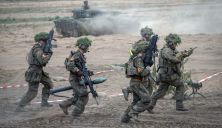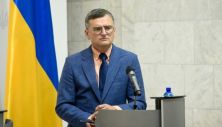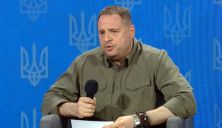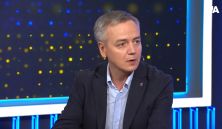The NATO-Ukraine Council met on Wednesday (28 August 2024) following recent heavy Russian airstrikes against Ukrainian civilians and infrastructure....
Vous n'êtes pas connecté
- English
- Français
- عربي
- Español
- Deutsch
- Português
- русский язык
- Català
- Italiano
- Nederlands, Vlaams
- Norsk
- فارسی
- বাংলা
- اردو
- Azərbaycan dili
- Bahasa Indonesia
- Հայերեն
- Ελληνικά
- Bosanski jezik
- українська мова
- Íslenska
- Türkmen, Түркмен
- Türkçe
- Shqip
- Eesti keel
- magyar
- Қазақ тілі
- Kalaallisut ; kalaallit oqaasii
- Lietuvių kalba
- Latviešu valoda
- македонски јазик
- Монгол
- Bahasa Melayu ; بهاس ملايو
- ဗမာစာ
- Slovenščina
- тоҷикӣ ; toğikī ; تاجیکی
- ไทย
- O'zbek ; Ўзбек ; أۇزبېك
- Tiếng Việt
- ភាសាខ្មែរ
- རྫོང་ཁ
- Soomaaliga ; af Soomaali
Rubriques :
 Maroc - EURASIAREVIEW.COM - A la une - 21/Jul 22:55
Maroc - EURASIAREVIEW.COM - A la une - 21/Jul 22:55
Strategic Indecision Prolongs NATO’s Incremental Approach To Ukraine – Analysis
By Vladimir Socor The North Atlantic Treaty Organization (NATO) celebrated its 75th anniversary at the Washington summit on July 9–11 but missed the chance to deliver historic decisions amid Russia’s onslaught on Ukraine—the biggest war in Europe since 1945. The alliance has not brought Ukraine any closer to being invited for membership accession talks, nor did it meet the hopes of announcing a road map to Ukrainian membership (seeEDM, July 17). In the run-up to the summit, US President Joe Biden publicly ruled out bringing Ukraine into the NATO fold (Time Magazine, June 4). The unprecedented, chilling word choice accurately reflects the administration’s policy in tandem with that of the German government. Absent a consensus among allies, the summit—NATO’s third since the beginning of Russia’s all-out invasion—failed to decide that the alliance supports Ukraine to win by defeating Russia. The conclave provided neither a strategic rationale for investing in Ukraine’s victory nor a guidance for containing Russia. Instead, the White House-inspired policy equates Ukraine’s victory with stopping Russia before it conquers even more territory, allowing for the survival of a reduced Ukraine, albeit Western-oriented, but outside NATO. Biden’s keynote speech at the summit made clear again that this is the current operational objective and considered a successful outcome (The White House, July 9). This situation stems, in turn, from the absence of a clear US and NATO policy toward Russia. The Washington Summit Declaration announces, “For our next Summit, we will develop recommendations on NATO’s strategic approach to Russia” (NATO, July 10, paragraph 21). Yet, this is the third consecutive summit at which NATO designates Russia as “the most significant and direct threat to Allies’ security” (Madrid 2022, Vilnius 2023, and Washington 2024). The reason why recommendations for an allied strategy toward Russia are only due in 2025 is not explained. Some deliverables, however, did materialize at the Washington Summit. NATO is now starting to provide lethal military assistance to Ukraine after many years of limiting itself to non-lethal aid. A few NATO member states had supplied some lethal assistance to Ukraine bilaterally, outside the alliance’s framework, before 2022. That meager assistance grew spectacularly after Russia’s full-scale invasion and is being coordinated by the Pentagon-led Security Assistance Group—Ukraine (Ramstein Group), comprised of some 50 NATO member and partner states, each acting in its own national capacity rather than on NATO’s behalf. The Washington Summit Declaration also established the NATO Security Assistance and Training for Ukraine (NSATU) to coordinate the provision of military equipment and training for Ukraine (the word “Mission” was ruled out of the title to avoid sounding belligerent) (NATO, July 10, paragraph 15). Acting on NATO’s collective behalf and comprised of almost all member states, the NSATU will operate primarily out of a pre-existing headquarters co-located with the US European Command in Wiesbaden, Germany (stopping short of a presence on the ground in Ukraine). The headquarters is due for expansion from 300 to 700 personnel with a three-star commander directly under the authority of the Supreme Allied Commander Europe. The NSATU will take over some of the Ramstein Group’s functions; the two are to operate in “mutual complementarity” according to the Pentagon (VOA, July 12). NATO had, until now, declined to associate itself “as NATO” (collectively) with the Ramstein Group for fear of appearing as a belligerent or lending credence to Moscow’s claims that NATO wages war against Russia. For such reasons, the alliance has refrained from mentioning the Ramstein Group in official documents. This attitude has now changed. The two forums will interact closely, but the division of labor between them has yet to be announced. Along with the NSATU, the Washington Summit approved a Pledge of Long-Term Security Assistance for Ukraine for the provision of military assistance, equipment, and training to the Ukrainian Armed Forces (NATO, July 10, paragraph 15 and attachment). NATO’s collective financial commitment is a minimum of 40 billion euros ($43.5 billion) per year, matching the allies’ aggregate military assistance delivered to Ukraine annually since 2022. The same amount is now budgeted for “the next year” (unclear whether the next 12 months or the 2025 calendar year). The “long-term” in the title is a remnant from NATO Secretary-General Jens Stoltenberg’s proposal for a five-year, 100-billion-euro ($109-billion) fund, which was debated in the run-up to the summit but ultimately replaced with year-to-year budgeting. The annual amount will be subject to review at each of the subsequent summits. Member states would contribute proportionately to their respective gross domestic products but also consider the value of their bilateral assistance delivered to Ukraine (i.e., subtracting that value from their contributions to the collective). The summit approved the establishment of a NATO-Ukraine Joint Analysis, Training, and Education Center, soon to open in Poland. The center shall investigate “apply[ing] lessons from Russia’s war against Ukraine.” Additionally, NATO will significantly raise its representation in Ukraine by appointing a senior representative assisted by civilian and military personnel in Kyiv. It is informally understood that this representative will be a former European high NATO official (RBK Ukraine, July 12). These deliverables are far from insignificant, particularly given NATO’s modest engagement “as NATO” (collectively) with Ukraine until now. The Madrid 2022 and Vilnius 2023 summits still defined NATO as a provider of non-lethal assistance to Ukraine. The Alliance is now finally starting to relate to Ukraine as a military actor rather than a non-lethal aid donor. Yet, the Washington summit withheld several urgently needed deliverables that Ukraine and supportive countries had reasonably hoped to see. Bringing Ukraine closer to an invitation to commence accession talks was one such expectation (seeEDM, July 17). Additionally, the US government refused permission for Ukraine to hit military targets deep inside Russia with US-supplied long-range missiles. Russian aviation is systematically striking Ukrainian civilian objects from Russian airspace after taking off from Russian bases within the range of US weapons. Stoltenberg supported Ukrainian President Volodymyr Zelenskyy’s argument that Ukraine had the right to defend itself by targeting the points of origin of those Russian strikes (NATO, July 11). Russian airstrikes on July 8 (on the eve of the summit) killed 44 Ukrainians in Kyiv, Krivyy Rih (Zelenskyy’s hometown), and wounded some 200, including casualties in a maternity hospital. Nevertheless, in unison, the White House, as well as State and Defense departments reaffirmed the restrictions on Ukrainian long-range strikes, citing the risks of escalation (Ukrainska Pravda, July 11). The summit announced the delivery of five Patriot air defense systems to Ukraine immediately (by five NATO member states). This placed Ukraine at the front of the waiting line for further Patriots on order in the United States and the arrival of a handful of F-16 fighter jets in Ukraine “this summer,” with possibly 100 to arrive next year. More than two years into the war, the tempo of arming Ukraine remains “incremental” (too little too late), based in part on subjective fears of escalation and partly in part, on low stockpiles and atrophied production capacities in most NATO countries (seeEDM, June 4). Three innovative ideas that had been tentatively aired in the run-up to the summit ran out of steam. Those were deploying non-combat military personnel behind the frontlines in Ukraine, creating an air defense shield over western parts of Ukraine, and basing or sheltering Ukrainian-flown F-16 fighters at airports in neighboring allied countries. The states that aired these ideas for possible consideration understood that they might not necessarily be covered by Article Five guarantees in the event of a clash with Russia. Proposals along those or similar lines may soon resurface from some forward-leaning countries out of increasingly stringent military necessity. The alliance’s overall approach, however, looks set to remain non-strategic, reactive, shaped by fears of escalation, deterred, and self-deterring— reluctant to coalesce around the political objective of victory in war and not fully realizing that Ukraine’s defeat would translate into NATO’s own. About the author: Vladimir Socor is a Senior Fellow of the Washington-based Jamestown Foundation and its flagship publication, Eurasia Daily Monitor (1995 to date), where he writes analytical articles on a daily basis. An internationally recognized expert on the former Soviet-ruled countries in Eastern Europe, the South Caucasus, and Central Asia, he covers Russian and Western policies, focusing on energy, regional security issues, Russian foreign affairs, secessionist conflicts, and NATO policies and programs. Mr. Socor is a frequent speaker at U.S. and European policy conferences and think-tank institutions; as well as a regular guest lecturer at the NATO Defense College and at Harvard University’s National Security Program’s Black Sea Program. Source: This article was published by The Jamestown Foundation
Articles similaires
Will the EU send a military mission to Ukraine?
The decision to send European military instructors to Ukraine may be made no later than November 2024, writes the German publication Welt. Since...
Kuleba to lobby for lifting restrictions on long-range strikes on targets in Russia at EU ministerial meeting
Ukrainian Foreign Minister Dmytro Kuleba wants to get support for lifting restrictions on long-range strikes on military targets in Russia at an...
Already 25 agreements: Yermak named Ukraine’s ultimate goal regarding security guarantee agreements
The ultimate goal of concluding agreements on security guarantees is Ukraine's membership in the European Union and NATO. This was stated today,...
Zelenskyy Stresses Need to Maintain Military Power
Ukrainian President Volodymyr Zelenskyy on Friday (6/9) called on his country's military allies to increase their weapons, underscoring the need for...
Zelenskyy Stresses Need to Maintain Military Power
Ukrainian President Volodymyr Zelenskyy on Friday (6/9) called on his country's military allies to increase their weapons, underscoring the need for...
We need to redesign the whole system UN Security Council, – an interview with Alexander Khara
What are the biggest challenges facing Ukrainian diplomacy during the Russian-Ukrainian war? Is Russia ready for negotiations? What is the role of...
Austin Says Using US Weapons For Long-Range Strikes No Game Changer In Ukraine
(RFE/RL) -- U.S. Defense Secretary Lloyd Austin said on September 6 that no single military weapon will be decisive for Ukraine to defeat Russia's...
Austin Says Using US Weapons For Long-Range Strikes No Game Changer In Ukraine
(RFE/RL) -- U.S. Defense Secretary Lloyd Austin said on September 6 that no single military weapon will be decisive for Ukraine to defeat Russia's...
Latvia, Lithuania and Estonia build a defense line in the Baltic
In the face of Russia's aggression, the Baltic states are making efforts to protect NATO's eastern border. As VOA correspondent Myroslava Gongadze...
Les derniers communiqués
-
Adobe Brings Conversational AI to Trillions of PDFs with the New AI Assistant in Reader and Acrobat
Adobe - 21/02/2024
-
Laura Frigenti takes the Helm as Chief Executive Officer of the Global Partnership for Education
Global Partnership for Education - 05/12/2022



